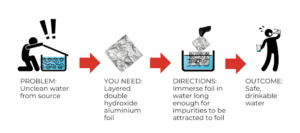Taufiq Ihsan, Lecturer of Environmental Engineering Department, Universitas Andalas, along with his colleagues, has created a foil that is covered in layered double hydroxide (LDH), a special material.
This substance attracts and holds microorganisms in its grasp, much like a magnet.
In laboratory experiments, they discovered that the LDH foil was surprisingly effective; in just a few hours, it was able to remove over 99% of E. coli bacteria, a common indicator of water contamination.
They discovered that in addition to targeting E. Coli, it is also effective against a variety of other aquatic diseases, such as bacteria, viruses, and parasites.
This indicates that the LDH provides all-around disease protection.
He said that their idea is not meant to be a stand-alone solution, and more testing will definitely be required, particularly in the field.
But we think it can be a useful supplement to current water treatment methods.
It can be used in conjunction with conventional techniques like boiling or filtering to ensure complete water safety and add one more layer of protection.

How LDH foil works?
The concept is not entirely new; the ability of layered double hydroxide to retain impurities has previously established.
The innovation was making it into a simple, easy-to-use foil.
The secret to the LDH foil’s magic is its capacity to absorb or seize harmful pathogens from water.
Absorption is the process of one material being taken up by another, like a sponge soaking up water.
Adsorption, on the other hand, occurs when things adhere to the surface of another material, much like when magnets are stuck to a refrigerator.
The science behind this process is fascinating.
The majority of microorganisms have a negatively charged surface, in contrast to the positively charged LDH surface.
The microorganisms are drawn to the LDH foil in an electrostatic manner, similar to how iron filings are drawn to a magnet, as a result of this.
Additional physical and chemical forces are involved contribute to making pathogens bind to the LDH surface, ensuring their effective removal from the water.
In order to determine how many bacteria the LDH foil could remove, they added bacteria to clean water in a lab and then dipped the foil in.
As different formulations showed slightly different adsorption rates, it turned out that the foil was exceptionally good at what it did: depending on the precise type of LDH foil employed, it eliminated more than 99% of the bacteria within 3 to 24 hours.
Being simple and affordable, it is to be piloted in African countries.
To get regular Food Industry updates, feel free to join our WhatsApp group: Joining link